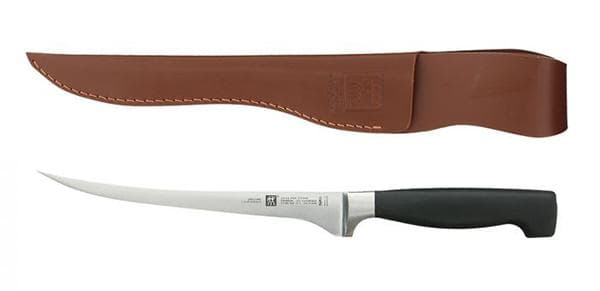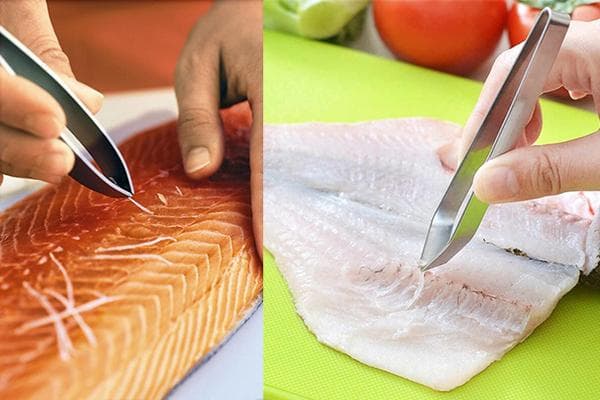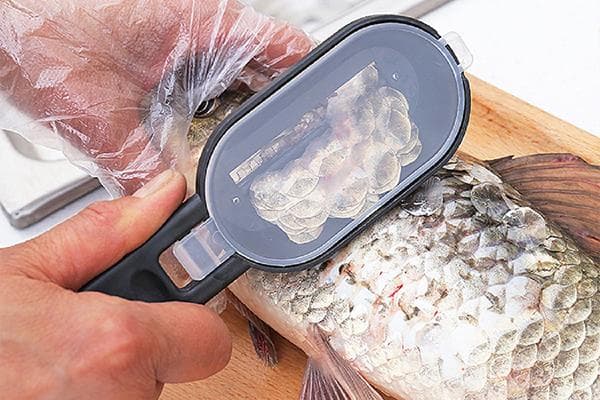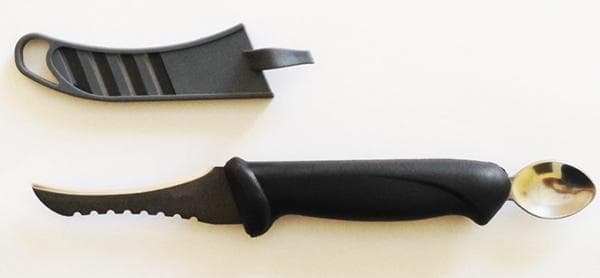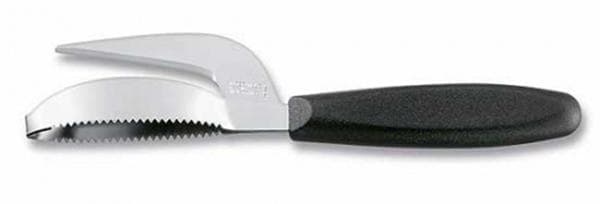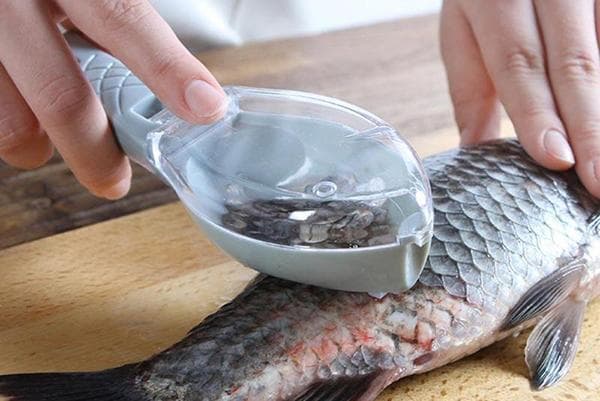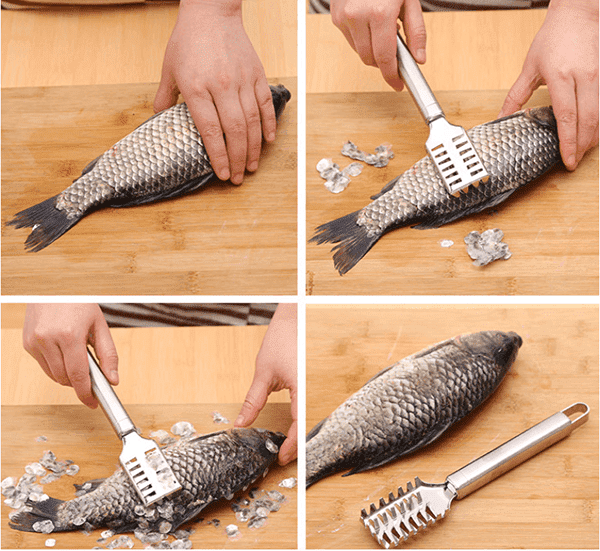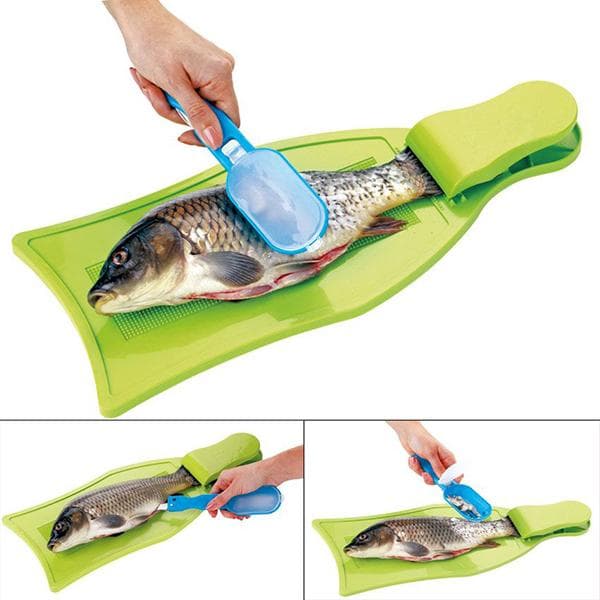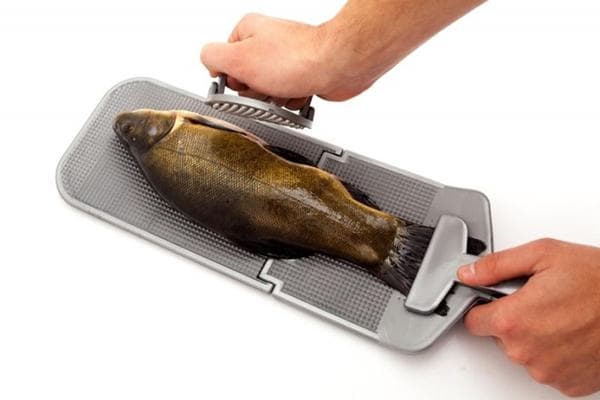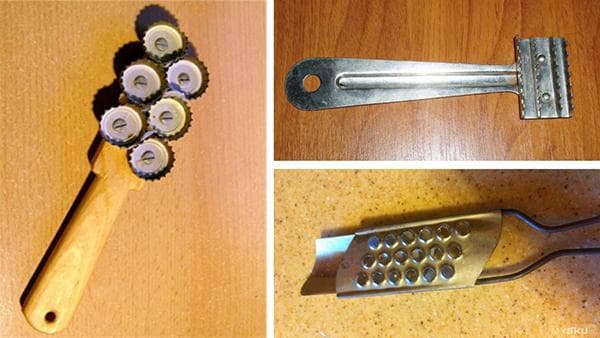How to quickly clean fish from scales - methods, secrets, devices
Content:
- How to get rid of scales quickly and easily?
- Fish cleaning equipment
- How to clean different types of fish?
Few people like to clean fish. Flying scales, mucus, sharp fins and small bones cause a lot of problems for those who decide to contact her. Is there a way to make the cleaning process easier? Definitely yes. Avid fishermen and professional chefs shared their secrets.
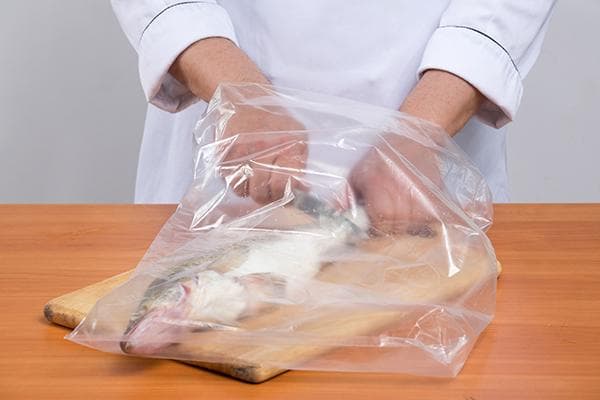
How to get rid of scales quickly and easily?
Fish scales are the most unpleasant thing. It tries to fly away in all directions and gets on your hands and hair. But this “volatility” of it can be very easily neutralized.
7 ways to clean fish from scales:
- Scalding (for river fish). Boil water in a saucepan and place the fish in it for 20–30 seconds. After this, the scales will be easily removed from the skin. The main thing is not to overdo it, otherwise the fish will be cooked.
- Paper trap. Cover your work surface with paper or newspaper.By doing this you will not only protect it from contamination, but also neutralize the “volatile” husk. It tends to stick to paper.
- Polyethylene trap. When cleaning, wrap the fish in a bag. It should be large enough for you to fit your fish, your hands, and your tools. When cleaning, all the scales will remain on the walls of the bag. All you have to do is throw it away and wash your fish.
- Vinegar solution (for marine fish). Make a solution of 1 liter of cold water and half a glass of vinegar. Soak the fish for 30–40 minutes. After this, the scales will come off much better.
- Freezing (for marine fish). Slightly frozen fish is cleaned much faster and easier. It is enough to keep a fresh carcass in the freezer for 30 minutes.
- Rock salt. To remove mucus from fish, rub it generously with coarse salt and rinse with running water. After this, it does not slip and is easy to handle. And to remove the scales along with the skin, they are left in salt for a day.
- Underwater cleaning. Fill a large basin with cool water and try to peel the scales from the fish right under the water. They definitely won't fly to the sides.
Let us remind you that the fish is cleaned from tail to head with the back of a knife, fork or special device. The carcass must not yet be cut. But it’s better to cut off the fins first so as not to prick.
To prevent the fish from slipping out of your hands, wrap the tail with a napkin or paper towel.
Fish cleaning equipment
If you or your family are fish lovers, you should get special tools for cleaning it. They will significantly facilitate and speed up the work process.
It is worth paying attention to the following devices:
- fish scaler or scraper;
- board with clamps;
- kitchen scissors;
- tweezers;
- fillet knife.
With a fish scaler or scraper you can clean not just one, but several fish carcasses in a matter of minutes. In this case, the scales will not fly apart. Kitchen scissors are very convenient for cutting off fins. A board with clamps is needed to fix the carcass, tweezers are needed to remove bones from the fillet. A fillet knife is for cutting meat from the bone. When you use it, nothing will remain on the bones, and the fillet seems even larger than the fish itself.
Fish scaler or fish cleaning knife
When cleaning fish, the tool is of great importance. To prevent the scales from flying, he must easily separate them without damaging the skin. There are many types of special tools: from knives to scrapers and electric fish scalers.
A regular paring knife has large serrations on the blade. It is not as convenient as scrapers, which also collect scales in a special bowl.
Fish cleaning board
It's no secret that you need to have a separate board for fish. It is best to purchase a special board with clamps for cleaning and cutting. The clothespin helps secure the carcass so that it does not slip or move.
Of all the varieties, the most practical is a plastic board with a corrugated surface. It does not absorb odors, unlike wood products.
Fish cleaning clamp
If you already have a fish board and don’t intend to part with it, you can purchase a clamp separately. Clips for cleaning fish are made of stainless steel and are relatively cheap - about 100 rubles. Install the clamp on the board and you will no longer worry about the fish slipping out.
Homemade device
You can make a tool for cleaning fish yourself from a piece of tin or a tin can. If you drill holes in them, sharp jagged edges will separate the scales.Attach the tip to a wooden spatula or block - and a complete device for cleaning fish is ready. Or you can make it even simpler - attach beer caps or an old grater to the blade with self-tapping screws. Example in the photo:
How to clean different types of fish?
The cleaning method largely depends on the type of fish. Some species have scales so small and soft that they are left behind. Other fish are cleaned of scales, removing them along with the skin. Before you clean and cut up a fish for the first time, you need to familiarize yourself with its features.
How to clean pike perch?
Pike perch is a very tasty and healthy freshwater fish of the perch family. It is distinguished by hard scales. In addition, it has sharp dorsal fins that can easily injure your hands. Therefore, if you are faced with a task how to clean pike perch, - first of all, the fins are always cut off, and then the pike perch is fixed on a cutting board and the scales are cleaned with a fish scaler, a special knife or a household device. This is the case when, for easy cleaning, it will be useful to use one of the life hacks: scalding with boiling water, cleaning under water.
How to clean pink salmon?
Pink salmon has small and soft scales. However, they need to be removed even if you plan to simply salt the fish.
How to clean pink salmon from scales quickly and effectively?
- Place the fish in the refrigerator for half an hour. Clean the frozen carcass when it is half defrosted. Try not to wet pink salmon.
- Grasp the tail and lightly scratch the fish towards the head. Do not use much force to prevent the scales from flying apart.
After cleaning, the fins are cut off and the gills are removed. If necessary, you can remove the skin using a thin and long fillet knife, prying it off at the tail. They also use it to fillet fish.
How to clean mackerel?
Mackerel is one of those rare fish that does not require cleaning before cooking. Instead of scales, it has a thin skin, which, as a rule, is not removed. You just need to cut off the fins, separate the head and remove the giblets, and then cut it up at your discretion.
How to clean pollock?
Pollock is a very popular sea fish. It is affordable, healthy, contains minimal bones and is very easy to clean. Its scales are so small and delicate that many do not notice them at all. But it is still correct to clean the pollock before cooking. To do this, remove the sharp fins, and then, holding the carcass by the tail, scrape off the scales against the growth. It is best to clean pollock when slightly frozen under running water.
How to clean carp?
Carp is an artificially bred fish, domesticated carp. Its meat has a sweetish taste and is highly valued in cooking. The fish has a large, tight-fitting skin, but is easy to clean:
- Dip the carp into water acidified with vinegar (dry scales do not easily come off the skin).
- Use scissors to cut off all fins except the tail fin.
- Insert your finger under the gills to secure the carcass.
- Use the thumb of your other hand to get under the scales near the tail.
- Move it smoothly under the scales, moving towards the fish's head.
- Do the same on the opposite side. The scales will be easy to remove without scattering to the sides.
And a special grater for this fish will eliminate the headache over the question - how to clean carp, if there is a lot of it, but free time is running short. Also in cooking, scales are often removed along with the skin. To do this you need a long and thin knife with a point. They penetrate under the skin of the fish at the tail part and carefully move along the entire length. Then the layer of skin is cut off.The procedure is repeated until all the skin is removed.
How to remove gills from carp?
When cooking fish with the head, the eyes and gills must be removed. To do this, use a sharp knife - and nothing more.
To properly remove gills from carp and other fish, follow this algorithm:
- Lift the operculum.
- Stick a knife inside
- Make deep cuts from the side of the ridge on one side and the other of the head.
- Cut the gills where they join the abdomen.
- Pull it towards you and take it out.
The gills are the easiest way to determine the freshness of fish: they are the first to spoil. If they are dense and reddish in color, then the fish is fresh.
How to clean crucian carp?
A river fish that everyone knows. Crucian carp makes excellent fish soup. And if you make cuts on the cleaned and cut up carcasses, then during frying all the small bones will soften and will be imperceptible.
Just like carp, crucian carp is cleaned with your fingers:
- Place the crucian carp in a deep bowl of water.
- Cut off the fins.
- Grasp the gills.
- Using your thumb, pry the scales off the tail.
- Brush it off, moving towards the head.
Despite the fact that the scales of crucian carp are large, they are quite soft and easily separated from the skin.
How to clean and cut trout?
Cleaning trout does not take much time. The scales of the fish are quite small and do not tend to fly apart. Usually it is scraped off with the blunt side of a knife, holding the fish by the tail. To prevent it from slipping, sprinkle your hands with salt or wrap the carcass with a paper napkin. Then the fish is washed and cut.
Trout can be cut in different ways depending on the cooking method:
- Roasting a whole carcass. The fish's fins are trimmed. Then a shallow incision is made from the anus to the gill. Take out the insides. Remove the black film.The gills are removed. Rinse under running water.
- Fillet, for sushi and salads. After removing the fins from the small fish, remove the skin in the manner of a stocking, picking it up at the head. Then they gut and fillet the fish. Large trout are first gutted, the head is cut off, and then the fillet and skin are removed, making a neat cut from the side of the ridge. The skin can be removed later using a fillet knife.
How to clean a dorado?
Dorado fish is also called sea carp. Most often there is no need to clean fish from scales - it is sold already cleaned. But if you come across a specimen with scales, do the following:
- Cut the fins off the carcass.
- Place the dorado in a large basin.
- Grab the tail and scrape off the scales directly under water (with a knife or special device).
- Remove the entrails, gills, or entire head.
The sea fish has a light belly, on which the scales are hardly noticeable. Nevertheless, it is there. Give this area plenty of attention.
How to clean bream?
Bream is a very tasty river fish. But like many other freshwater species, it is covered with dense large scales. To remove it, you have to make an effort, which can cause the scales to fly around the room. It is best to clean bream in a bag, under water or by scalding with boiling water. A fish scaler with a cup will also come in handy here, as it will simultaneously clean and collect scales.
Dried fish begin to be cleaned by removing the fin on the back. It is pulled out, and then an incision is made along the length of the ridge and the skin along with the scales is carefully removed. Then all that remains is to separate the head and take out the insides of the fish.
How to clean carp?
Carp is a common carp. The fish has darker golden scales and an elongated body.Perhaps this is one of the most difficult fish to clean: the scales are very large, dense and do not want to separate from the surface.
It is better to entrust the cleaning of the carp to a man, leaving him alone with the fish in the bathroom. If this option is not possible, we recommend removing the scales along with the skin (see Cleaning carp).
The fresher the river fish, the easier it is to clean. The best way to do this is while fishing.
Cleaning fish with a screwdriver
This curious method was invented by fishermen. To clean carp, carp, bream and other river fish from scales, you can use a screwdriver and a concrete anchor. You need to place the fish on a newspaper and use a rotating anchor to treat its surface. Cleaning with a screwdriver is carried out according to the growth of the scales, and not against (from head to tail), otherwise they will scatter even more than when cleaning with a knife.
How to clean burbot?
The predatory representative of the cod family has tasty and tender meat, which has practically no bones. It is often served in expensive restaurants. But when cooking at home, many housewives complain about an unpleasant aftertaste. The whole point is that you need to clean the burbot correctly. Main secret how to clean burbotTo avoid bitterness in its meat, remove the skin along with the scales:
- Rub the carcass with salt and rinse with water.
- Cut off the fins.
- Find the junction of the carcass and the head under the gills.
- Pierce the skin with your fingers on both sides.
- Insert a knife into the hole and cut the skin around the head and above the gills.
- Pull the skin by the cuts, turning it inside out like a stocking. To remove the skin easily, wrap it in a paper towel or grab it with pliers and pull down sharply.
- Make a shallow cut from the anal fin to the head.
- Carefully remove the insides.
Gutting fish (any fish) must be done very carefully so as not to rupture the gall bladder hidden in the giblets. When bile gets on the meat, it becomes very bitter, and even repeated washing does not help. The only thing left to do is throw the spoiled carcass away.
Cleaning fish at home is not difficult if you understand the intricacies. Using special tools and secrets, you can easily get rid of scales.
